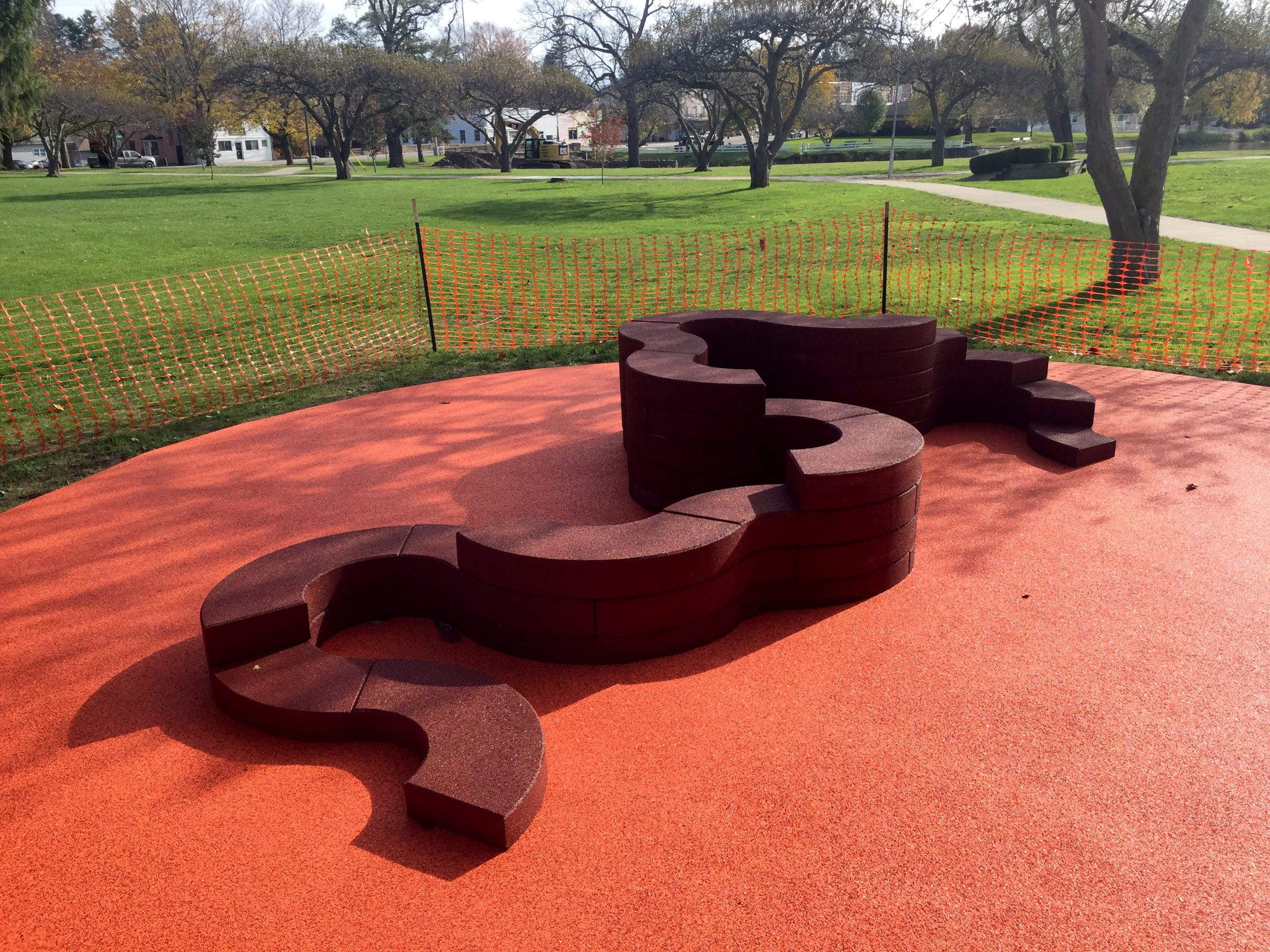In February, we profiled Coryn Kempster and Julia Jamrozik, founders of an emerging multidisciplinary architecture practice whose arresting play structures reconsider the form and context of traditional playground elements. Winners of the League Prize of the Architectural League of New York in 2018, the inventive duo designed a circular swingset in Buffalo, brought a pink parkour course to the streets of Toronto, and elevated the game of telephone to the level of art, with an interactive sound installation in the Eastmen Reading Garden outside the Main Library in Cleveland.
Selfishly, though, our favorite creation of theirs is one we helped to realize and introduce to new users: Curvy Blocks. Of the many new products we unveiled at this year’s ASLA Conference on Landscape Architecture in San Diego—including the Crazy Maze—the Curvy Blocks are, perhaps, the most open-ended and versatile. The modular EPDM rubber C and S shaped blocks give designers freedom to craft curvilinear forms for any number of uses: seating, gathering, spatial partitions, and climbing and jumping arrangements. The blocks are fabricated as individual units and can be reconfigured in custom-built structures, offering near limitless flexibility in design.

Curvy Block installation at Lyndonville Elementary School by designers Coryn Kempster and Julia Jamrozik
We’re happy to see all the attention they received at the trade show; it’s a welcome milestone in the development of an exciting new partnership. Curvy Blocks grew out of a KaBOOM! Play Everywhere Challenge grant awarded to Kempster and Jamrozik for their proposal to design and install three scalable play interventions in underprivileged communities in western New York. The first blocks were installed at Lyndonville Elementary School in Orleans County, in October, with the goal of bringing children, caregivers, and the broader public together to gather and play.
As the designers note in the grant proposal, [Curvy Blocks] are both a playspace and a piece of furniture.” They can be fused together in “a long sinuous configuration for multiple occupations by different people at the same time. The curvilinear shape of the bricks creates nooks and moments of proximity, within the overall linear form . . . the bold colors attract attention and provide a light-hearted touch.”
Kampster and Jamrozik believe, over time, Curvy Blocks will help build trust and fellowship between the school and community. “There are families in the community who are reluctant to allow perceived authority figures enter their home and are similarly wary of entering the school building and this prevents them from accessing municipal programs and services that might otherwise be of great help to them. Having a recognizable and approachable outdoor place could over time become known as a safe space and work as a catalyst to involve these families in community events where it might be possible to connect them with the services that could help them most,” they write in the proposal.

Curvy Blocks on EPDM rubber panels
To the uninitiated, seating may seem like a minor design consideration, but it has assumed an important role in emerging discussions surrounding the social role of architecture. If you’ve ever had to wait at length for a bus, but found no place to sit (or for your child to sit), you understand how valuable comfortable, available seating can be in public settings. At a park, playground, library, or pediatric waiting room, it is no different: We feel more at ease in places where we are at liberty to rest our legs.
It is not just the absence of seating that can be disappointing; uninviting seating can be just as bad, or worse. Recent years have seen social critics documenting cases of overtly hostile architecture or defensive design: built features implemented through the mandates of city planners or private developers that intentionally deter homeless people from sleeping. These range from slanted benches to aggressive armrests, to grated air vents and street spikes. Suffice to say these designs are not intended to be comfortable. Or inclusive.
Curvy Blocks are the antithesis of hostile architecture. They are made with resilient rubber surfacing, they are wheelchair accessible, and they invite users of all ages and circumstances to enjoy them. At Lyndonville Elementary School, they are configured close to the school entrance, where they have a dual life, serving children and adults. A significant number of the students’ primary caregivers are grandparents, and there are few places for them to sit and wait for kids at pickup. The Curvy Block structures provide a much-needed resting place for adults, and double as a play space for kids, bringing together generations who stand to benefit from each other’s company. There are future plans to use them for reading clubs and other small group activities.
At a time of year when we celebrate inclusiveness and human companionship, it seems fitting to recognize a project that epitomizes these values. We’re grateful to have such wonderful partners in Coryn Kempster and Julia Jamrozik and thrilled to see the connections the Curvy Blocks are already fostering at Lyndonville Elementary School. We can’t wait to see what creative, socially minded designers will do with them next!

 RSS Feed
RSS Feed